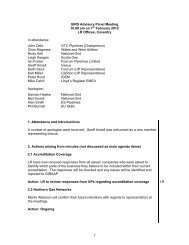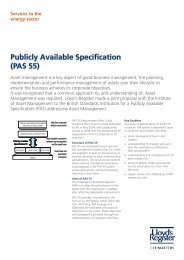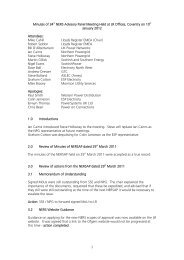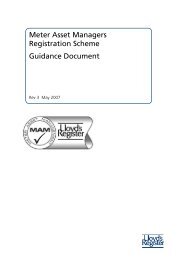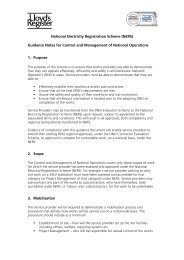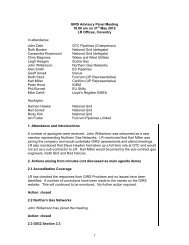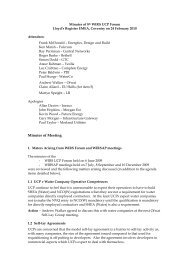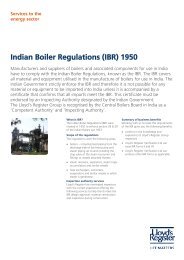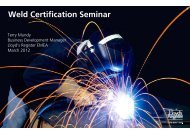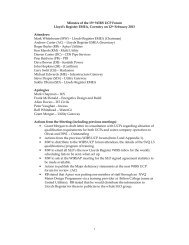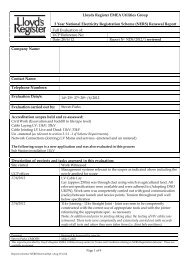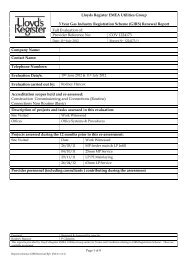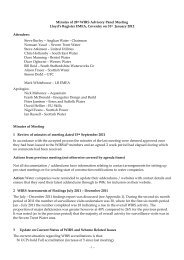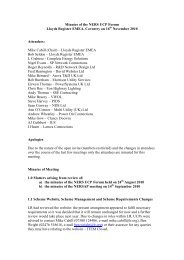27th WIRSAP Advisory Panel Meeting 15-09-2011 ... - Lloyd's Register
27th WIRSAP Advisory Panel Meeting 15-09-2011 ... - Lloyd's Register
27th WIRSAP Advisory Panel Meeting 15-09-2011 ... - Lloyd's Register
You also want an ePaper? Increase the reach of your titles
YUMPU automatically turns print PDFs into web optimized ePapers that Google loves.
Attendees:<br />
Minutes of 27 th WIRS <strong>Advisory</strong> <strong>Panel</strong> <strong>Meeting</strong><br />
Lloyd’s <strong>Register</strong> EMEA, Coventry on <strong>15</strong> th September <strong>2011</strong><br />
Steve Burley – Anglian Water - Chairman<br />
Jeremy Wilson – Welsh Water<br />
Dylan Smith – Severn Trent Water<br />
Steve Atkinson – United Utilities<br />
Mike Sunderland – Yorkshire Water<br />
Dave Manning – Bristol Water<br />
Dave Ogborne – Wessex Water<br />
Ian Russell – Scottish Water<br />
Alison Fraser – Scottish Water<br />
Simon Dodd – GTC<br />
Frank McDonald – Energetics Design and Build<br />
Gary McConnell – Aquamain<br />
Grant Morgan – Utility Gateway<br />
Martyn Speight – LR EMEA<br />
Mark Whitehouse – LR EMEA<br />
Apologies:<br />
Nick Mahoney - Aquamain<br />
Bill Reid – South Staffordshire Waterworks Co<br />
David Hellier – EU Skills<br />
Peter Jamison – Essex and Suffolk Water<br />
Minutes of <strong>Meeting</strong><br />
1. Introductions<br />
Scottish Water wish to apply WIRS accreditation in their area and Ian Russell and Alison Fraser were<br />
attending representing Scottish Water and to outline the work content they wish to see covered by<br />
WIRS. They were welcomed to <strong>WIRSAP</strong> along with Grant Morgan of Utility Gateway as a new UCP<br />
representative.<br />
2. Review of minutes of meeting dated 17 th March <strong>2011</strong><br />
In accordance with the accepted process the minutes of the last meeting were deemed approved once<br />
they had been issued to the <strong>WIRSAP</strong> members and an agreed 2 week period had elapsed during which<br />
no comments had been received.<br />
3 WIRS Assessments of Findings Jan <strong>2011</strong> – June <strong>2011</strong><br />
The January – June <strong>2011</strong> findings report was discussed (see Appendix 1). During the fist six month<br />
period of <strong>2011</strong> the number of surveillance visits undertaken was 18, where for the period Jan 2010 – Dec<br />
2010 the number completed was 25 indicating a rise in the overall WIRS activity. It was noted that the<br />
majority of overall activity for surveillance visits was in the Severn Trent Water area. The group<br />
discussed that unannounced surveillance visits would be beneficial to monitor the WIRS activity;<br />
however this would be dependant on Lloyds <strong>Register</strong> having prior knowledge of UCP work activities in<br />
water companies’ areas. If this information could be co-ordinated then unannounced visits in<br />
- 1 -
surrounding areas could be done when scheduled surveillance visits are being undertaken. See item<br />
No.7 of these the minutes.<br />
4 Review of WIRS Forum<br />
As discussed at the WIRS Forum the feeling amongst UCPs from the WIRS Finding report was that<br />
<strong>WIRSAP</strong> may view poorly the reported number of deficiencies, both major and minor. UCPs were<br />
concerned that the data is being viewed in isolation without any benchmarking against water companies<br />
own labour or contractors performance. UCPs would like water companies to provide their audit<br />
findings to enable comparisons to be made between UCPs and their own direct labour/contractors.<br />
Water representatives on <strong>WIRSAP</strong> concluded that there is not direct correlation between independent<br />
audits undertaken by their own auditors and WIRS audit work being carried out on UCPs and therefore<br />
sharing their own findings would not benefit the process.<br />
UCPs were concerned at the communication arrangements with water companies. Not all<br />
documentation/addendums have information relating to contact arrangements for setting up pre-start<br />
meetings or for sending start of construction notifications to water companies.<br />
Action: Water Companies to update their addendums/websites with contact details<br />
On behalf of UCPs Frank McDonald has produced a template of key information that UCPs need to be<br />
able to quickly reference in water company self-lay addendums. UCPs would like to see this template<br />
being referenced when addendums are next updated.<br />
5 Update on Current Status of WIRS and Scheme Related Issues<br />
The current situation regarding WIRS accreditations is that:<br />
31 UCPs hold Full accreditation (decrease of 1 since last meeting)<br />
21 UCPs hold Partial accreditation (increase of 3 since last meeting)<br />
a. feedback on investigations instigated by water companies<br />
LR has received a number of referrals from water companies and, whilst reflecting compliance issues,<br />
these are welcomed. Many of the reported issues can be traced back to weaknesses in the front end of<br />
the process as not all water companies have comprehensive information on their web sites. Water<br />
companies also can delay notifying LR whilst they do checks themselves. This makes it difficult for LR<br />
to follow-up any weaknesses and, if necessary, highlights the risks of losing their WIRS accreditation to<br />
UCPs. Where issues are brought to the attention of LR they will carry-out an investigation and feedback<br />
to the water company.<br />
Action: LR to feedback to water companies when investigation instigated by them has been concluded<br />
b. take up of connections scope<br />
LR reported there are 4 SLO’s that hold ‘Full’ Accreditation for the CRMC scope category and currently<br />
have been a number of applicants going through the ‘Partial’ Process of working towards accreditation.<br />
c. NCO(W) Registrations<br />
The ‘experienced worker’ route for Network Construction Operations (Water) registration expired on 30<br />
June <strong>2011</strong>. Applications now either have to be by operatives already holding NVQ, or equivalent,<br />
qualifications or enter via the new NCO(W) – Trainee category which has been set-up to allow for<br />
training and NVQ assessments. The trainee scope can only be held for a fixed duration of 12 months,<br />
from the date of registration.<br />
- 2 -
Given the NCO(W) registration constraints WIRS now allows, subject to water company agreement,<br />
UCPs to use operatives who are ‘under NVQ assessment’ on a site specific basis. Where this<br />
arrangement applies the water company agreement to the use of named operatives needs to be<br />
documented. However it is evident, following site visits, that a number of NCO(W) registrations had<br />
expired and UCPs had not confirmed with water companies the ongoing use of operatives who were in<br />
this situation. Following discussions it was agreed that water companies did not wish to receive details<br />
of individuals who were working on site specific projects in their areas. So, in the short term, until the<br />
operatives have gained their NCO(W) registration it was proposed that operatives shall carry evidence<br />
that their competence to do the work being carried out has been assessed by an appropriately technically<br />
competent person, that they are registered with a training provider for NCO(W) assessment and that<br />
they are actively undergoing whatever training and assessment they need to complete the NVQ<br />
requirements for NCO(W) registration.<br />
Action: LR to draft and circulate to <strong>WIRSAP</strong> members amended WIRS requirements wording. Subject<br />
to general acceptance of this wording LR to update the WIRS Requirement document<br />
No issues were raised by <strong>WIRSAP</strong> concerning the scheme or UCP accreditations<br />
6 WIRS in Scotland<br />
a. overview<br />
Ian Russell of Scottish Water gave <strong>WIRSAP</strong> an overview of the introduction of WIRS in Scotland.<br />
The Water Industry Commission for Scotland has set a target date on Scottish Water of April 2012 to<br />
open up competition in their area to cover water mains and service connections. This also is to cover<br />
meter installation and maintenance activities. Scottish Water has asked Lloyd’s <strong>Register</strong> to develop<br />
WIRS to cover these activities and it is envisaged that the following scopes will be created solely for use<br />
in Scotland.<br />
- Construction Routine Under Pressure Mains Connections (CRUPC)<br />
- Construction Non-Routine Basic Branch Mains Connections (CNRBC)<br />
- Construction Non-Routine Complex Mains Branch Mains Connections (CNRCC)<br />
- Small Routine Meter Installation Maintenance (SRMIM)<br />
- Internal Routine Meter Installation Maintenance (IRMIM)<br />
- All Routine Meter Installation Maintenance (ARMIM)<br />
Details of the scopes were discussed and whilst some of the detail is still being finalised with Scottish<br />
Water <strong>WIRSAP</strong> agreed to sign-off the proposed changes to the WIRS Requirements document subject to<br />
LR asking (via email) for <strong>WIRSAP</strong> member approval should there be any significant changes to the<br />
current proposals..<br />
Action: LR to update WIRS Requirement Document and notify <strong>WIRSAP</strong> members should further<br />
significant changes be needed to satisfy Scottish Water requirements<br />
b. governance arrangements<br />
There will continue to be a single national <strong>Advisory</strong> <strong>Panel</strong> (<strong>WIRSAP</strong>) that has full responsibility for the<br />
WIRS scheme and which signs-off the scheme requirements. Initially, to facilitate roll-out and smooth<br />
implementation in Scotland, there will be a Scottish Water WIRS <strong>Advisory</strong> Group (SWWAG) that will<br />
oversee the development of the new scopes and ensure that the scheme guidance adequately covers the<br />
working arrangements in Scotland.<br />
It is proposed, once the scheme is established in Scotland, that a Scottish WIRS Forum will be set up<br />
whereby all holding accreditation in Scotland can discuss any concerns they have about the scheme in<br />
Scotland<br />
- 3 -
Scottish Water have yet to sign the WIRS memorandum of Understanding and this will be done once the<br />
changes to governance arrangements have been finalised.<br />
Scottish Water representation on <strong>WIRSAP</strong> needs to be agreed with Steve Burley (as Water UK coordinator)<br />
Actions: LR to update WIRS MoU and issue to Scottish Water<br />
Scottish Water WIRS representation to be agreed with Steve Burley<br />
b. charging<br />
LR presented an update to the WIRS <strong>2011</strong>/12 charges to incorporate the additional scopes being<br />
introduced for Scottish Water. These retain the previously established level of charges.<br />
In making these changes LR is proposing that the current assessment for mains and service laying is split<br />
into an initial assessment for mainlaying to be followed by a separate assessment to obtain the service<br />
laying scope. This would not change the total cost.<br />
UCP representatives had some concerns about the assessment costs when a scope extension draws on<br />
elements of scopes that were already held. LR stated that they were mindful of this and would only<br />
charge for actual time spent when the scope evaluation did not require all the elements built into the<br />
charges.<br />
<strong>WIRSAP</strong> accepted the changes and agreed to their implementation<br />
Action: LR to publish the charges covering the new scopes<br />
7 WIRS activity monitoring<br />
Whilst LR have exposure to work undertaken by UCPs these visits are undertaken by prior<br />
arrangement, and currently there is no mechanism to undertake audit ‘spot checks’ on UCPs in the field<br />
or to ensure that all work being done by UCPs is being considered when visits are being planned. This<br />
would require a better knowledge base either from water companies, who should hold the information<br />
where UCPs are working in their areas, or from UCPs themselves. If UCPs were to be expected to<br />
provide the information it would need to be made a WIRS requirement. If information was available it<br />
would enable audit spot checks to be undertaken by LR when they are in a surrounding area completing<br />
a scheduled visit.<br />
Water companies felt that the information could be provided by themselves and Steve Burley agreed to<br />
discuss this with the Water UK Developer Services group.<br />
Action: Steve Burley of consider the practicality of water companies providing LR with details of<br />
ongoing water self-lay pojects<br />
8 LR contact for water industry liaison<br />
Martyn Speight indicated that it is his intention to leave LR in the early part of 2012. It is therefore<br />
appropriate that Mark Whitehouse should now become the primary LR contact for WIRS matters.<br />
(Mark can be contacted on 07786961027 or mark.whitehouse@lr.org)<br />
LR assured <strong>WIRSAP</strong> that they are making arrangements to ensure that there is adequate WIRS assessor<br />
coverage and are already thinking about introducing contract assessor support to enhance coverage in<br />
Scotland.<br />
- 4 -
9 Updates<br />
a. EUSR<br />
EU Skills have provided a comparison table covering the various NVQ modules for both the Gas and<br />
Water Network Construction Qualifications. The table (see Appendix 2) sets out the qualification<br />
structure providing information on both core mandatory units for mainlaying/service laying together<br />
with generic core mandatory units. It also gives details of additional units that can be taken undertaken.<br />
Whilst not relevant to WIRS the table also includes qualifications for repairs and maintenance activities.<br />
b. Ofwat<br />
Ofwat are currently restructuring their operations and as Andrew Walker is leaving Ofwat he will no<br />
longer be their <strong>WIRSAP</strong> representative. <strong>WIRSAP</strong> members wished Andrew well, and thanked him for<br />
his contribution over his time he had been a representative. It is understood that Clair Daniel will be the<br />
lead Ofwat contact on self-lay matters and whether she intends to attend <strong>WIRSAP</strong> needs to be<br />
established.<br />
Action:<br />
LR to contact Clair Daniel to discuss Ofwat representation on <strong>WIRSAP</strong><br />
10 A.O.B<br />
a. Standard Application Forms<br />
UCPs reported a lack of standard application forms between water companies for self-lay work. This<br />
was particular problem with point of connection requirements. Following the Developers UK meeting,<br />
Steve Burley reported back that due to the differing requirements of information of water companies<br />
that it would not be possible at this time to introduce a standard application form.<br />
b. NVQ Deign Qualifications<br />
Water Skills UK are currently introducing an NVQ Design Qualification all interested water<br />
companies/UCPs should contact Pete Featherstone at Water Skills UK<br />
Confirmation of 2012 <strong>Meeting</strong> dates<br />
The dates of the proposed <strong>WIRSAP</strong> meetings for 2012 are as follows;<br />
31 st January, 26 th June and 23 rd October 2012<br />
LR will hold WIRS UCP Forum meeting and the proposed dates are as follows;<br />
14 th February, 12 th June and 9 th October 2012<br />
The meetings to be held at the LR offices in Coventry<br />
- 5 -
Appendix 1 - WIRS Assessment Visit Findings Summary Report - 2010<br />
This report summarises the findings from surveillance visit and renewal assessments of<br />
companies holding WIRS accreditation.<br />
A. Surveillance Visits<br />
During 2010<br />
25 surveillance visits were carried out on the 33 UCPs holding ongoing WIRS accreditation<br />
6 of these visits resulted in major deficiencies being identified<br />
21 of these visits resulted in minor deficiencies being identified<br />
The actual findings are detailed below.<br />
Major deficiencies being were immediate rectification action is required with minor deficiencies<br />
being where the remedial action needs to be completed before the next visit.<br />
Fewer visits were carried out than scheduled. This was due to<br />
- some UCPs only became accredited during 2010 (hence their first visit is not yet due)<br />
- some visits planned for December got delayed by the weather<br />
- the impact of fairly low workloads with many UCPs<br />
- the status of some UCPs has dropped to Partial (as they have no WIRS work). This<br />
includes Barhale and Morgan Sidnell and the accreditation of Balfour Beatty has been<br />
suspended as they are overdue their renewal.<br />
Through surveillance a total of 44 minor deficiencies were identified (just under 2 per visit),<br />
these are summarised in the following chart<br />
WIRS SV Deficiency Summary - 2010<br />
5% 2% Competency<br />
11%<br />
30%<br />
Method<br />
statements/instructions<br />
Equipment/PPE<br />
Auditing<br />
52%<br />
Other<br />
The detailed breakdown of deficiencies being provided in the following chart.<br />
- 6 -
Details of WIRS Surveillance Deficiencies Raised in 2010<br />
No of minor deficiencies<br />
8<br />
7<br />
6<br />
5<br />
4<br />
3<br />
2<br />
1<br />
0<br />
Competency Assessments Not Complete/Up to Date<br />
Assistant not registered (or out of date) with EUSR<br />
Hygiene card not current<br />
EUSR Water SHEA out of date<br />
EUSR Cards not available for operative on site<br />
Technical Advisor role not adequately defined<br />
Induction (incl subcontractors) inadequate<br />
Company ID Card out of date/not available on site<br />
Work specification is inadequate<br />
Work specification to developer & groundworkers inadequate<br />
Method statements/policy docs out of date or not signed off<br />
Method statements do not fully cover work activities<br />
Errors/inacuracies in method statements/risk assessments<br />
Work not being done fully to required standards<br />
Work processes do not adequately check subcontractors<br />
Work controls do not adequately control private servicelaying<br />
Material not adequately checked on site<br />
Fittings not adequately stored<br />
Equipment defective/not in calibration<br />
Full set of equipment (shelter/rollers etc.) not available<br />
Hand scraper being used/barrier removal tool not available<br />
Appropriate PPE not available<br />
Audit programme inadequate/does not cover all work activities<br />
Audit findings not adequately followed up<br />
Adequate briefings not provided to all staff<br />
B. Renewal Assessments<br />
During 2010 6 WIRS renewal assessments were completed. These assessments identified:<br />
- 26 major deficiencies (requiring action before re-accreditation awarded)<br />
- 23 minor deficiencies<br />
Many of the deficiencies are linked to ensuring compliance with the updated Code of Practice<br />
and related water company procedures. The reported numbers are also somewhat raised<br />
because of the way LR tends to separately identify each independent occurrence.<br />
WIRS Renewal Deficiency Summary - 2010<br />
4% 6% 21%<br />
Work Instruction & Control<br />
23%<br />
Methods of Working<br />
Competency<br />
Sub Contractor Controls<br />
Other<br />
45%<br />
Full details of the actual findings are given below. (Note some duplicates have been combined).<br />
Work Issue and Control<br />
- 7 -
Major - Work Activity Procedure needs to be reviewed and updated to reflect Self-Laying of Water<br />
Mains and Services 2 nd Edition Code of Practice.<br />
Major - Management of variations is not being adequately controlled which has allowed mains to be laid<br />
at variance to the alignment shown on the design drawing<br />
Major – UCP is not able to demonstrate processes and procedures for managing work from inception<br />
through to adoption by the adopting utility. These processes and procedures should:-<br />
- define role responsibilities<br />
- specify the level and type of information to be provided at the key transfer stages<br />
- indicate response times (in accordance with water company requirements)<br />
- capture which water company area each job is in<br />
Major - End-to end process for managing work from acceptance/specification through to adoption for the<br />
installation of mains and services is required. This needs to include all interfaces between the SLO, water<br />
utility and client and cover working in all water utility areas where the SLO is active.<br />
Major - Return to work form (following sickness) does not contain sufficient information to ensure that<br />
employees are medically fit to return to work following Gastric or Waterborne disease<br />
Major - Arrangements need to be documented covering the management of variations, such that it is clear<br />
to the operatives what constitutes both ‘major and ‘minor’ variations. It also needs to specify which types<br />
of variations need to be referred back to the designer.<br />
Minor - Setting-out confirmation of site layout is not being obtained from the developer (or their<br />
groundworkers) when work is being done in advance of the road layout starting to be constructed<br />
Minor - Improved arrangements for managing variations needs to be established on site<br />
Minor - Activity flow charts from planning to commissioning need to be reviewed as last review date was<br />
April 2007.<br />
Minor – Operational procedure needs review to verify that it ensures that the requirements of adopting<br />
utilities are being satisfied.<br />
Methods of Working<br />
Major - Additional Method Statements required to cover, service laying of barrier pipe systems, electrofusion<br />
of PE pipes, installation of boundary box external meters and details of feedback to host water<br />
company.<br />
Major - Work controls are not adequate to ensure technical compliance with industry and utility specific<br />
requirements (this could identify the need for a specialist water technical advisor)<br />
Major - Method statements have not been reviewed to ensure compliance with version 2 of the national<br />
water industry Code of Practice<br />
Major - On completion Method Statements and Risk Assessments need to be ‘authorised’ by a competent<br />
person<br />
Major - Weekly on-site risk assessment sheet not completed - a weekly/daily sheet should be introduced<br />
for the labour only contractors to complete on a daily basis and when completed to be filed in the<br />
completion file<br />
Major - Health and Safety file on-site needs to be signed by Staff & labour only contractors.<br />
Major - Water Method Statements Manual available on site, however this was dated 06/07 and had not<br />
been reviewed. This should to be reviewed updated and re-issued to all Teams.<br />
Minor - Risk assessment review sheets need to include title of risk assessment to which it relates.<br />
- 8 -
Minor - Method Statement for service laying not included in documentation. This needs to include that<br />
checks have been made to ensure that the private pipework meets the host water company requirements<br />
prior to connection being made<br />
Minor - Method statements need to be reviewed to ensure that they capture the requirements stated in the<br />
2nd Edition of the national Self-Lay Code of Practice and industry best practice.<br />
Minor - Need to ensure that COSHH data sheets for chloros tablets and de-chlorination agents are<br />
available on the Sypol system, and to be deployed in Operatives Packs.<br />
Minor - Method Statements need to be enhanced to include;<br />
- De-banding of coiled pipework<br />
- Installation of manifolds<br />
Minor - Method Statement for Service Laying needs to include minimum spacing of service pipes on<br />
water mains.<br />
Minor - Method Statement for Pipe Jointing needs to include the jointing of barrier pipe systems using<br />
fluid couplings and where allowed by host Water Company, the jointing and wrapping of barrier pipe<br />
systems using electro-fusion couplings for both mains and services.<br />
Minor - Coiled pipe and sticks need to be stored off ground<br />
Minor - Method Statement required for the installation of Boundary Box meters<br />
Minor - Provision and control of PPE; whilst matrix identifies PPE issued evidence is also required to<br />
confirm that this has been received and signed for by staff/labour only contractors<br />
Minor - No reference to use of shelter for electrofusion welding in service laying method statement and<br />
gang were using a hand scraper to prepare the pipe<br />
Minor - Risk Assessments should be reviewed annually and include review date<br />
Minor - COSHH sheets did not include Instachlor tablets<br />
Minor - Service laying procedure should include checks, before work is authorised, that only services<br />
which have been approved by the host water company, or self certified, should be connected.<br />
Technical Standards<br />
Major - Copy of Version 2 of the national self-lay code of practice not held and therefore not able to be<br />
referenced, along with updated water company specific addendum, to specify methods of working<br />
Role Competency Requirements<br />
Major - Competency assessments on all staff involved in WIRS delivery are not documented and up to<br />
date.<br />
Major - Site supervision arrangements are not adequate to ensure that the work is constructed to<br />
specification and in accordance with health and safety and quality criteria<br />
Major - Role descriptions are not adequate to clearly specify all roles involved with WIRS delivery and<br />
ensure that roll holders perform in accordance with the WIRS delivery procedures.<br />
Major - Operative engaged on water self lay activities did not hold a valid water hygiene card<br />
Major - A review of Supervisors, Team Leader and Operatives qualifications needs to be done to ensure<br />
compliance with the Network Construction Operations (Water) and hygiene requirements. An integrated<br />
competency matrix needs to be completed for all who can be engaged on water activities.<br />
- 9 -
Major - A competency framework needs to be produced for all involved in constructing, supervising and<br />
auditing self-lay work<br />
Major - Job / Role profiles of all personnel engaged in WIRS work need to be produced. This includes<br />
Technical Advisor, Supervisors, Team Leaders, and Operatives (mainlaying/service laying and testing<br />
and disinfection) etc…. Job/Role profiles need to including qualifications, training and experience.<br />
Major - Competency assessment forms for labour only sub contractors need to signed and dated by<br />
individuals<br />
Minor - Competency gaps are not being routinely identified such that training requirements can be<br />
recognised<br />
Minor - Competency matrix for labour only sub-contractor, needs to include review date<br />
Minor - Job Description for supervisor needs to include for NCO (W) Supervisor requirement in<br />
qualification in his current capacity.<br />
Sub Contracted Work<br />
Major - Adequate guidance is not been given to developers (and their groundworkers) detailing aspects of<br />
the construction work not being directly done by the UCP<br />
Minor - Need to specify the arrangements with the separate (in-house) service provider of testing and<br />
disinfection services such that:-<br />
- work instructions clearly state the work to be done<br />
- which water company standards are being worked to is stated<br />
- it is clear whether the method statements being worked to are those of the UCP or their<br />
service provider<br />
Contract Documents and Record Controls<br />
Major - Records being kept of mainlaying jobs are not adequate to determine the current status of each<br />
job<br />
Technical Audit<br />
Minor - UCP needs to ensure that their technical audits adequately cover the range of work being done<br />
and that additional checks are being done by a water competent person (especially until the competence<br />
of the new staff is fully established). The audit proforma should also be improved to describe the work<br />
being done at the time of audit.<br />
Note<br />
This report has been prepared as a draft for consultation with <strong>WIRSAP</strong> on the format they would like to<br />
see for such reporting on an ongoing basis.<br />
- 10 -
Appendix 2 - Comparison of Gas and Water Network Construction Qualifications (<strong>2011</strong>)<br />
Core mandatory units<br />
MUNC001 – Create an efficient and effective work environment<br />
MUNC003 – Establish and maintain effective working relationships<br />
MUNC005 – install equipment for safe working on sites<br />
MUNC006 – Locate and avoid supply apparatus<br />
MUNC007 – Excavate and maintain holes and trenches<br />
MUNC0<strong>09</strong> – Operate powered tools and equipment for routine and predictable requirements<br />
Additional core mandatory for gas<br />
MUNC002 – Maintain a safe and secure working<br />
environment on gas network construction<br />
Additional core mandatory for water<br />
MUNC002 – Maintain a safe and secure working environment on water network<br />
construction<br />
Mainlaying mandatory<br />
units<br />
MUNC010 – Joint<br />
materials by electrofusion<br />
MUNC011A – Joint<br />
materials by butt fusion<br />
processes up to 180mm<br />
MUNC013C – Install gas<br />
engineering products or<br />
assets up to 180mm<br />
MUNC0<strong>15</strong>A – Conduct<br />
specified testing of gas<br />
engineering products or<br />
assets – mains<br />
Servicelaying mandatory<br />
units<br />
MUNC010 – Joint<br />
materials by electrofusion<br />
MUNC013A – Install gas<br />
services up to 63mm<br />
MUNC0<strong>15</strong>B – Conduct<br />
specified testing of gas<br />
services<br />
Mainlaying mandatory<br />
units<br />
MUNC010 – Joint<br />
materials by electrofusion<br />
MUNC011A – Joint<br />
materials by butt fusion<br />
processes up to 180mm<br />
MUNCW012 – Joint<br />
materials by mechanical<br />
means<br />
MUNCW013C – Install<br />
water mains up to <strong>15</strong>0mm<br />
NB (180mm)<br />
Servicelaying mandatory<br />
units<br />
MUNCW012 – Joint<br />
materials by mechanical<br />
means<br />
MUNCW013B – Install<br />
water services up to 50mm<br />
NB (63m PE)<br />
Repair and maintenance<br />
mandatory units<br />
MUNC004 – Install<br />
equipment for safe<br />
working on the highway<br />
MUNC010 – Joint<br />
materials by electrofusion<br />
MUNCW012 – Joint<br />
materials by mechanical<br />
means<br />
MUNCW013B – Install<br />
water services up to 50mm<br />
NB (63m PE)<br />
MUNCW018 – Restore<br />
Water components to<br />
operational condition by<br />
repair<br />
- 11 -
Distribution specific mandatory units<br />
MUNC004 – Install MUNC004 – Install<br />
equipment for safe equipment for safe<br />
working on the highway working on the highway<br />
MUNC016 Conduct<br />
specified connections to<br />
gas network mains and<br />
commissioning<br />
MUNC004 – Install<br />
equipment for safe<br />
working on the highway<br />
MUNC004 – Install<br />
equipment for safe<br />
working on the highway<br />
n/a<br />
Repair and maintenance specific mandatory units<br />
MUNC019 – Restore gas components to operational<br />
condition by repair<br />
MUNC020 – Assess and minimise risks to life, property<br />
and the environment during gas escapes<br />
MUNC021 – Conduct specified testing of gas network<br />
associated with leakage location<br />
MUNC022 – Analyse and interpret the results of<br />
surveys to determine the location of gas escapes<br />
Network Construction Operations (Gas)- Main layer (level 2)<br />
There are three pathways through this qualification:<br />
• Network construction operations (Gas)- Mainlayer (Self lay)<br />
• Network construction operations (Gas)- Mainlayer (Distribution)<br />
• Network Construction operations (Gas) - Mainlayer (Repair and Maintenance)<br />
Network construction operations (Gas)- Mainlayer (Self lay) = 11 units (all core mandatory units + additional core mandatory for gas + all Mainlaying<br />
mandatory units)<br />
Network construction operations (Gas)- Mainlayer (Distribution) = 13 units (all core mandatory units + additional core mandatory for gas + all<br />
Mainlaying mandatory units + all distribution specific mandatory units)<br />
Network construction operations (Gas)- Mainlayer (Repair and Maintenance) = 17 units (all core mandatory units + additional core mandatory for gas<br />
+ all Mainlaying mandatory units + all distribution specific mandatory units + all repair and maintenance specific mandatory units)<br />
- 12 -
Network Construction Operations (Gas)- Service layer (level 2)<br />
There are three pathways through this qualification:<br />
• Network construction operations (Gas)- Service layer (Self lay)<br />
• Network construction operations (Gas)- Service layer (Distribution)<br />
• Network construction operations (Gas)- Service layer (Repair and Maintenance)<br />
Network construction operations (Gas)- Service layer (Self lay) = 10 units (all core mandatory units + additional core mandatory for gas + all Service<br />
laying mandatory units)<br />
Network construction operations (Gas)- Service layer (Distribution) = 11 units (all core mandatory units + additional core mandatory for gas + all<br />
Service laying mandatory units + all distribution specific mandatory units)<br />
Network construction operations (Gas)- Service layer (Repair and Maintenance) = <strong>15</strong> units (all core mandatory units + additional core mandatory for<br />
gas + all Service laying mandatory units + all distribution specific mandatory units + all repair and maintenance specific mandatory units)<br />
Network Construction Operations (Water)- Main layer (level 2)<br />
There are two pathways through this qualification:<br />
• Network construction operations (Water)- Mainlayer (Self lay)<br />
• Network construction operations (Water)- Mainlayer (Distribution)<br />
Network construction operations (Water)- Mainlayer (Self lay) = 11 units (all core mandatory units + additional core mandatory for water + all<br />
Mainlaying mandatory units)<br />
Network construction operations (Water)- Mainlayer (Distribution) = 12 units (all core mandatory units + additional core mandatory for water + all<br />
Mainlaying mandatory units + distribution specific mandatory unit)<br />
- 13 -
Network Construction Operations (Water)- Service layer (level 2)<br />
There are two pathways through this qualification:<br />
• Network construction operations (Water)- Service layer (Self lay)<br />
• Network construction operations (Water)- Service layer (Distribution)<br />
Network construction operations (Water)- Servicelayer (Self lay) = 9 units (all core mandatory units + additional core mandatory for water + all<br />
Servicelaying mandatory units)<br />
Network construction operations (Water)- Servicelayer (Distribution) = 10 units (all core mandatory units + additional core mandatory for water + all<br />
servicelaying mandatory units + distribution specific mandatory unit)<br />
Network Construction Operations (Water)- Repair and Maintenance (level 2)<br />
There is one pathway through this qualification:<br />
Network construction operations (Water)- Repair and Maintenance = 12 units (all core mandatory units + additional core mandatory for water + all<br />
repair and maintenance mandatory units + distribution specific mandatory unit)<br />
In addition to the units required for achievement of each qualification, learners may decide to complete additional units from the list below where<br />
they are required to complete these activities as part of their job role. Please note that achievement of additional units does not contribute to<br />
achievement of the qualification. If taken, these units will be listed on the certificate as additional units.<br />
- 14 -
Additional units<br />
Network Construction<br />
Operations (Gas)- Main<br />
layer (level 2)<br />
Network Construction<br />
Operations (Gas)-<br />
Service layer (level 2)<br />
Network Construction<br />
Operations (Water)-<br />
Main layer (level 2)<br />
Network Construction<br />
Operations (Water)-<br />
Service layer (level 2)<br />
Network Construction<br />
Operations (Water)-<br />
Repair and Maintenance<br />
(level 2)<br />
MUNC11B – Join<br />
materials by butt fusion<br />
process above 180mm<br />
MUNC013E – Install<br />
engineering products or<br />
assets above 180mm<br />
MUNC008 – Reinstate<br />
excavation and pavement<br />
surfaces after utility<br />
network construction<br />
MUNC008 – Reinstate<br />
excavation and pavement<br />
surfaces after utility<br />
network construction<br />
MUNC13G – Install<br />
external service risers<br />
MUNC023 –<br />
Disconnection of meters<br />
MUNC008 – Reinstate<br />
excavation and pavement<br />
surfaces after utility<br />
network construction<br />
MUNC011C – Join<br />
materials by butt fusion<br />
process above 3<strong>15</strong>mm<br />
MUNC011D – Join<br />
materials by butt fusion<br />
process between 180 to<br />
3<strong>15</strong>mm<br />
MUNC0W13D – Install<br />
engineering products or<br />
assets from <strong>15</strong>0mm NB<br />
(180mm) to 300mm NB<br />
(3<strong>15</strong>mm)<br />
MUNCW013F – Install<br />
engineering products or<br />
assets above 300mm NB<br />
(3<strong>15</strong>mm)<br />
MUNCW014 – Conduct<br />
specified testing of Water<br />
engineering products or<br />
assets<br />
MUNCW018 – Restore<br />
Water components to<br />
operational condition by<br />
repair<br />
MUNC008 – Reinstate<br />
excavation and pavement<br />
surfaces after utility<br />
network construction<br />
MUNC010 – Joint<br />
materials by electrofusion<br />
MUNCW018 – Restore<br />
Water components to<br />
operational condition by<br />
repair<br />
MUNC008 – Reinstate<br />
excavation and pavement<br />
surfaces after utility<br />
network construction<br />
MUNC011A – Joint<br />
materials by butt fusion<br />
process up to 180mm<br />
MUNC011C – Join<br />
materials by butt fusion<br />
process above 3<strong>15</strong>mm<br />
MUNC011D – Join<br />
materials by butt fusion<br />
process between 180 to<br />
3<strong>15</strong>mm<br />
MUNC0W13D – Install<br />
engineering products or<br />
assets from <strong>15</strong>0mm NB<br />
(180mm) to 300mm NB<br />
(3<strong>15</strong>mm)<br />
MUNCW013F – Install<br />
engineering products or<br />
assets above 300mm NB<br />
(3<strong>15</strong>mm)<br />
MUNCW014 – Conduct<br />
specified testing of Water<br />
engineering products or<br />
assets<br />
- <strong>15</strong> -
- 16 -



